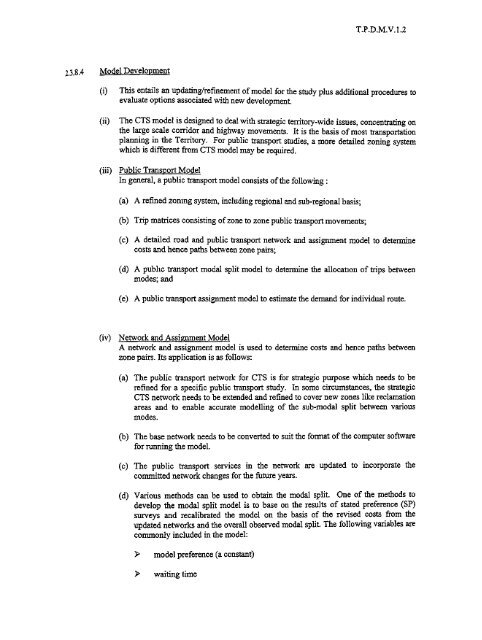Transport Planning - HKU Libraries - The University of Hong Kong
Transport Planning - HKU Libraries - The University of Hong Kong
Transport Planning - HKU Libraries - The University of Hong Kong
- No tags were found...
You also want an ePaper? Increase the reach of your titles
YUMPU automatically turns print PDFs into web optimized ePapers that Google loves.
T.P.D.M.V.L22.3.8.4 Model Development(i)(ii)This entails an updating/refinement <strong>of</strong> model for the study plus additional procedures toevaluate options associated with new development.<strong>The</strong> CTS model is designed to deal with strategic territory-wide issues, concentrating onthe large scale corridor and highway movements. It is the basis <strong>of</strong> most transportationplanning in the Territory. For public transport studies, a more detailed zoning systemwhich is different from CTS model may be required.(iii) Public <strong>Transport</strong> ModelIn general, a public transport model consists <strong>of</strong> the following:(a) A refined zoning system, including regional and sub-regional basis;(b) Trip matrices consisting <strong>of</strong> zone to zone public transport movements;(c) A detailed road and public transport network and assignment model to determinecosts and hence paths between zone pairs;(d) A public transport modal split model to determine the allocation <strong>of</strong> trips betweenmodes; and(e) A public transport assignment model to estimate the demand for individual route.(iv) Network and Assignment ModelA network and assignment model is used to determine costs and hence paths betweenzone pairs. Its application is as follows:(a) <strong>The</strong> public transport network for CTS is for strategic purpose which needs to berefined for a specific public transport study. In some circumstances, the strategicCTS network needs to be extended and refined to cover new zones like reclamationareas and to enable accurate modelling <strong>of</strong> the sub-modal split between variousmodes.(b) <strong>The</strong> base network needs to be converted to suit the format <strong>of</strong> the computer s<strong>of</strong>twarefor running the model.(c) <strong>The</strong> public transport services in the network are updated to incorporate thecommitted network changes for the future years.(d) Various methods can be used to obtain the modal split. One <strong>of</strong> the methods todevelop the modal split model is to base on the results <strong>of</strong> stated preference (SP)surveys and recalibrated the model on the basis <strong>of</strong> the revised costs from theupdated networks and the overall observed modal split. <strong>The</strong> following variables arecommonly included in the model:> model preference (a constant)> waiting time

















